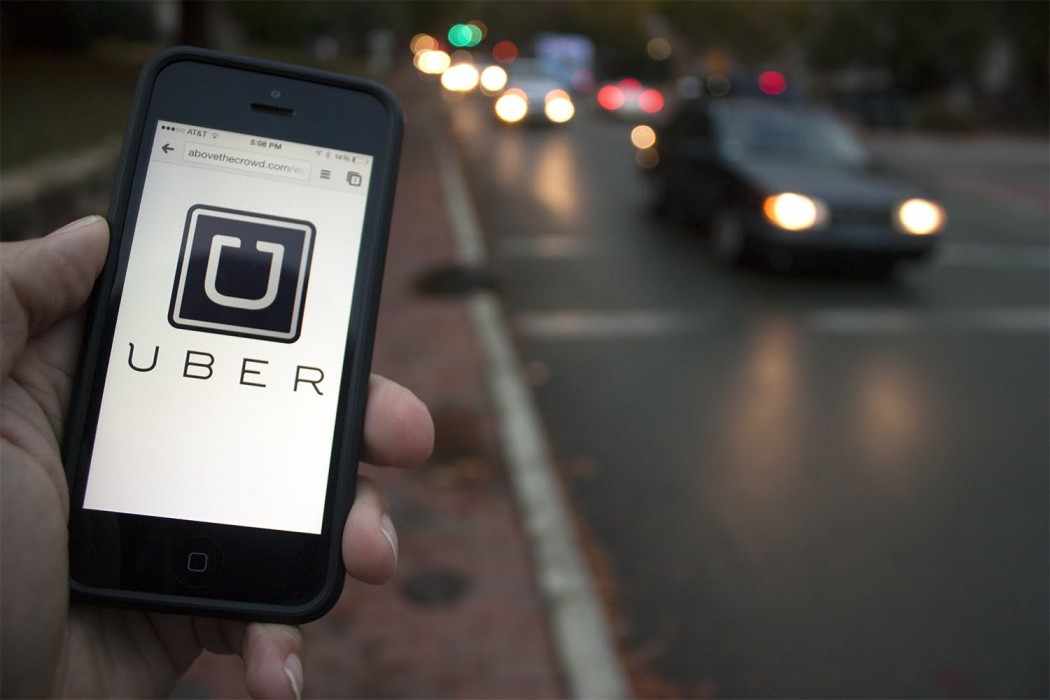Millions around the world have been scanning their smartphone screens for the black-and-white Uber icon, only to find it replaced by a colorful geometric shape – hexagonal if they drive, circular if they’re a rider – surrounding a small, bit-like square. The colors and patterns will vary from each of the 65 launch countries, but the app will still open with an elegant, patterned animation welcoming users to the new Uber.
Since Uber’s conception in 2009, it has grown to become more than just a transportation app service. A rebranding has long been overdue. Indeed, the story of how Travis Kalanick, Uber’s CEO, and his design team came to replace the ubiquitous “U” logo is about more than a corporate rebranding effort. It’s a coming-of-age tale. It’s about Uber’s attempt to cement a new reputation and dominance in the age of rapid technological innovation and cut-throat “everything on-demand” business world – to change not only how it is perceived throughout the world, but also how it perceives itself.
The inspiration behind this new aesthetic has been debunked in a video released on the official Uber website, in which Uber’s culture has been described as the combination of bits and atoms. The bits represent the machine efficiency involved in Uber’s mapping and dispatch software. The atoms represent the people.
Apparently, fusing the basic building block of our universe with one of the brilliant technological inventions of our generation ends up in an app that coordinates logistics. Much to Uber’s dismay, the somewhat presumptuous attitude of Uber showcased in the new logo design doesn’t bode too well with the public. A crowdsourcing site, DesignCrowd, has recently created a contest to redesign the redesigned logo. But the bold statement of weighing itself to be just as fundamental as bits and atoms reflects the ambitions of Kalanick. Just as controversial as Uber’s latest rebranding, Kalanick’s business endeavors in recent years have come under fire from the taxi industry, regulators around the world, and his rivals.
The “Uber Effect” – “the Good”
Let’s start with why Uber has been so successful so far.
We all know how Uber works, you open up the app, you enter your destination, hit “Request”, and minutes later, a friendly driver is here to greet you in a polished car. At the end of the trip, you have the driver’s name, face, and a receipt with a breakdown of the charges plus a map of the route you took. The app asks for you to rate your driver to assure the quality of service – even you, as a customer, get rated. The logistics of all this reassure you that you are more likely to trust an Uber driver than you would a traditional taxi driver.
Uber’s freelance drivers enjoy flexible working hours and are spared the formalities of qualifying as a conventional cab driver. On average, over 75% of gross fares end up in their hands, allowing drivers to get a fairer share for their services. Its fares are “dynamic” – they undercut conventional taxis most of the time, but go up during peak times like Friday and Saturday nights. This encourages more of its drivers onto the roads when they are most needed and customers can always get a car quickly, even if it sometimes costs a bit more. This encourages them to keep using Uber, in turn providing lots of work for its drivers.
It soon becomes difficult for any rival to match the liquidity of Uber’s market in rides. Once people download Uber on their smartphones, the firm can use this opportunity to introduce new services to its customer base. Examples include a strategic partnership with Carnegie Mellon University to establish an advanced technologies center to conduct research on autonomous self-driving cars, finding resourceful ways to accept cash payments in India, forging innovative partnerships with CapitalOne, Starwood, Spotify along with other firms, and launching UberRUSH, UberEATS, UberFRESH, and any other upcoming Uber[fill in the blank] services.
One might think that given the great reception of Uber from customers and drivers, having enough people to keep using the service to the tune of more than 2 million rides a day, there is nothing really fundamentally wrong with it. It perfectly encapsulates economist Joseph Schumpeter’s “Creative Destruction”, when something better kills the predecessor. Which makes the restrictions and hatred from government regulators and taxi drivers Uber is faced with seem like a nuisance. Oppositions may not be playing nice, but Uber is no saint either.
“The Bad and the Ugly”
Uber is the subject of ongoing protests and legal action from taxi drivers, taxi companies and governments around the world who are trying to stop Uber from operating in their areas. The resistance is viral, and the deadlock has navigated its way into our area. Not long ago on February 10th, Montreal taxi drivers slowed traffic around Pierre Elliott Trudeau International Airport in the morning. Plane passengers faced longer-than-usual waits for taxis, and highway traffic heading to the airport got bogged down by a convoy of protesting drivers. Protest groups say that Uber presents unfair competition to taxis because the company does not pay taxes or licensing fees, endangers passengers, and employs untrained, unlicensed and uninsured drivers. Quebec Transport Minister Jacques Daoust, a strong opposition of the newfangled service says he will make sure Uber ceases its “illegal” operations in the city and open its books to Revenue Quebec to allow the government to recover taxes it claims the company hasn’t paid with a court order.
Uber holding a competitive advantage over taxicabs by cutting corners on regulatory rules could be bad for the public interest. Worries about unsafe Uber cars or unsafe driving are, of course legitimate, but the experience of riding in a cab in many cities hardly invites confidence that the taxi system is much better.
Despite the immense success of Uber, currently being valued at $18.2 billion, and having a ubiquitous presence in our daily lives with a coined namesake term, it may be a little early to concede its triumph. Since its app — the core of its business model — is “easy to replicate”, and the startup costs are low enough to entice new competitors to enter the market. Although, the biggest threat to Uber is perhaps not aspiring new entries, but the reigning of the world’s largest smartphone-based transport service, Didi Kuaidi, its Chinese counterpart. Last year alone, Didi Kuaidi arranged 1.4 billion rides in China, more than Uber has done worldwide in its history. Backed by Tencent and Alibaba, the two largest Chinese Internet companies, Didi Kuaidi is currently valued (as of February 2016) at approximately US$20 billion, according to Reuters. Uber China, despite measuring up as Didi’s closest rival in mainland, is currently valued at a mere US$8 billion in comparison. These figures are evidences that government restrictions, Didi Kuaidi’s omnipresence and heavyweight backing simply means that it is going to be difficult for Uber to expand operations in this vast land where 1.3 billion resides, and where the demand for transportation is colossal.
But what’s more worrisome about Uber is its business ethics. According to an interview with Oregon’s Portland City Commissioner Steve Novick, Uber is said to “use extremely aggressive tactics such as bullying and hiring investigators to ‘dig up dirt’ on journalists who criticize them”. To sabotage its competitors, one incident in early 2014 was particularly striking. In January, Uber employees in New York City deliberately ordered rides from Gett, a newly established competitor, only to cancel them later. The purpose of the fake orders was two-fold: wasting drivers’ time to obstruct legitimate customers from securing a car, and offering drivers incentives — including cash — to join Uber. Steve Novick called Uber management “a bunch of thugs,” and that is a rather more accurate comparison than bits and atoms.
In a competitive market, profit is the main propeller for the churning of any new innovation or commercial product. Uber’s attempt to drive out competition in an unethical manner could make it a target of public mistrust. Its Nietzschean “winner-takes-all” ideals have become little more than a defense of privilege. It’s up to lawmakers to make sure that Uber’s distinctly undemocratic corporate values don’t become society’s own. Uber can stand a chance against widespread commotion from taxi monopolies on a global scale, and lobby for jurisdictions to work in their favor because Uber has the public majority on its side, and they adore the product. Once public perception shifts against it, Uber could face a major downfall. Brishen Rogers, an associate professor at Temple University, sums this all up succinctly: “Uber may become the Myspace or Netscape of ride-sharing. That is, a pioneer that could not maintain its market position.”
Uber’s success is based not merely on undercutting regulatory rules, but on creating a far more efficient market for car-hire services. I believe the execution, speed and skills wielded by Uber in a market environment can potentially help them overcome non-market challenges with the right commitment and motivation. While losing out on Chinese customers may be insufferable, Uber should not take it too seriously to heart, as foreign multinationals often struggle in China. Facebook, Twitter and Google are largely irrelevant in the mainland, but it doesn’t mean they are not the biggest sharks in the sea.
Nothing about this thriving, expansive yet volatile segment is absolute, or certain. But love it or hate it, I think Uber will very likely win in the end. Uber is here to stay, and that could be a good thing.


